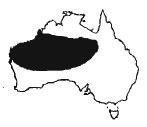Varanus Brevicavda
 |
Boulenger 1898
Short-tailed guanna.
The short-tailed goanna is the smallest living monitor lizard, and quite possibly the smallest species that has ever existed. They live in desert regions of Western Australia, Northern Territory and Queensland, most often in areas of spinifex. Maximum size is 23cm (12cm SVL) and gravid females may weigh as much as 20g. A specimen 9.9cm SVL caught in January weighed 9.5g. (Gow 1981; Storr & Hanlon 1980; Storr & Hanlon 1985; Pianka 1972, pers.comm.).
Very little is known about this delightful little lizard. Although they are found over a wide area they do not seem to be common anywhere and comparatively few specimens are known. In the Great Victoria Desert they may be most active between November and January. Short tailed goannas live in burrows or shelter under stones. In captivity they dig extensively. Like other dwarf monitors they feed on lizards and invertebrates (orthopterans, beetles, caterpillars and termites). However their diminutive size restricts them from feeding on many lizards and invertebrates form the bulk of their prey. They also feed on lizards' eggs, suggesting that they hunt for prey below ground. In captivity the short-tailed monitor is known to habitually grasp the tails of geckoes it is unable to overpower and swallow them when they are cast off. An active body temperature of 35.4°C has been reported (Slater1964; Pianka 1970, 1994; Schmida 1974).
This species has been bred in captivity (Schmida 1974, 1995). An enclosure of .7m2 with a deep sand substrate is suitable. Light cycles and temperatures should fluctuate seasonally. Breeding coincides with the return of warm weather. Incredibly, females are capable of producing up to eight eggs (in three clutches) over six months. Eggs hatch after 42-85 days at temperatures of 18-25°C. Hatchlings measure less than 8cm TL and weight less than 3g. Sexually maturity is allained around 8-9cm SVL. In captivity they can grow to adult size within two years. Short-tailed monitors are reported to be somewhat fussy in captivity; they will not take dead prey nor will they eat even the smallest manunals (Greer 1989).




